First Exam Homework Assignments
advertisement
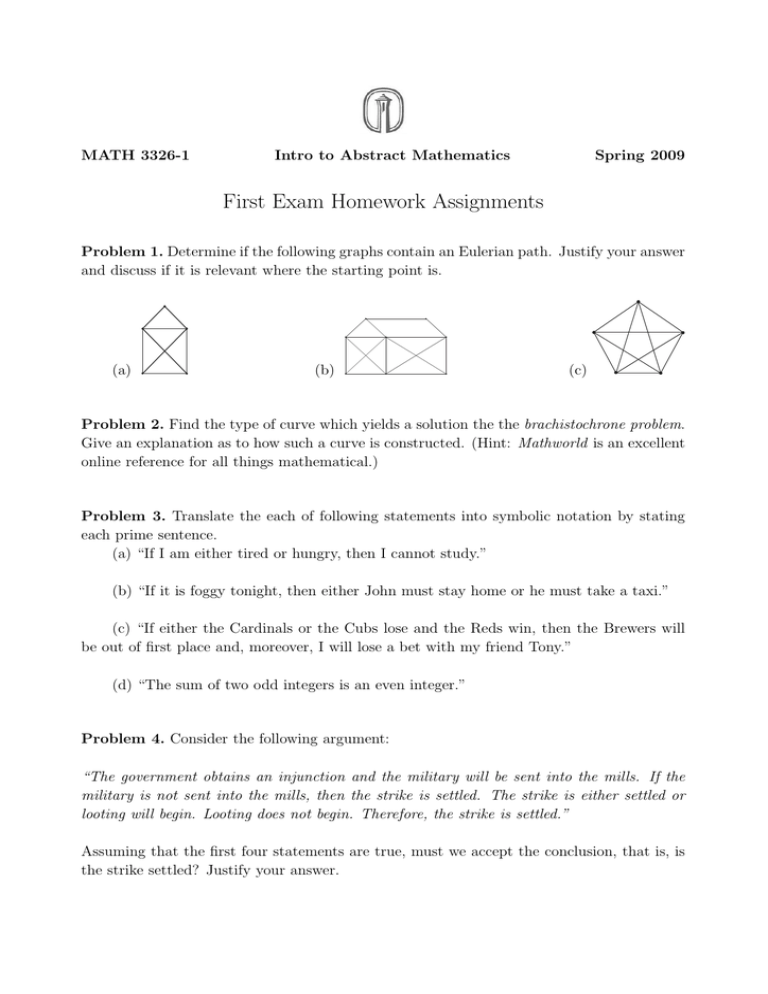
MATH 3326-1
Intro to Abstract Mathematics
Spring 2009
First Exam Homework Assignments
Problem 1. Determine if the following graphs contain an Eulerian path. Justify your answer
and discuss if it is relevant where the starting point is.
(a)
(b)
(c)
Problem 2. Find the type of curve which yields a solution the the brachistochrone problem.
Give an explanation as to how such a curve is constructed. (Hint: Mathworld is an excellent
online reference for all things mathematical.)
Problem 3. Translate the each of following statements into symbolic notation by stating
each prime sentence.
(a) “If I am either tired or hungry, then I cannot study.”
(b) “If it is foggy tonight, then either John must stay home or he must take a taxi.”
(c) “If either the Cardinals or the Cubs lose and the Reds win, then the Brewers will
be out of first place and, moreover, I will lose a bet with my friend Tony.”
(d) “The sum of two odd integers is an even integer.”
Problem 4. Consider the following argument:
“The government obtains an injunction and the military will be sent into the mills. If the
military is not sent into the mills, then the strike is settled. The strike is either settled or
looting will begin. Looting does not begin. Therefore, the strike is settled.”
Assuming that the first four statements are true, must we accept the conclusion, that is, is
the strike settled? Justify your answer.
Problem 5. Assume P , Q, and R are statements. Find the truth table for each of the
following statements.
(a) (R ↔ P ) → ((¬P ) ∨ R)
(b) (Q ∧ R) → (P → (Q ∨ (¬R)))
Problem 6. Compute the truth tables for ¬(P ∨ Q) and (¬P ) ∧ (¬Q). What do you notice
about their truth values?
Problem 7. Assume P , Q, and R are statements. Verify that each of the following pairs of
statements are logically equivalent.
(a) P → (Q ∧ R) and (P → Q) ∧ (P → R)
(b) P ∨ (Q ∧ R) and (P ∨ Q) ∧ (P ∨ R)
(c) ¬(P ∧ Q) and ((¬P ) ∨ (¬Q))
(d) P ↔ Q and (P → Q) ∧ (Q → P )
Problem 8. Show that the product of two odd numbers is an odd number.
Problem 9. For a, b, c ∈ Z, show that if a|b and a|c, then a|(b + c).
Problem 10. Show that log2 (3) is irrational.
Problem 11. All prime numbers greater than 2 are odd.
Problem 12. Negate the following statement in a meaningful way.
For every x ∈ Q, there exists y ∈ N such that sin(xy) = 1 or cos(x + y) = 12 .
Problem 13. As a definition, we say that a function f (x) is continuous at x = a if for
every ² > 0, there exists δ > 0 such that if |x − a| < δ, then |f (x) − f (a)| < ². Negate this
definition of continuity in a meaningful way.
Page 2
Problem 14. Let a, b, c ∈ Z. Show that if a|b and b|c, then a|c.
Problem 15. Negate the following statements in a meaningful way.
(i) The product of two rational numbers is rational.
(ii) The product of two irrational numbers is irrational.
Problem 16. Determine if each of the above statements is true of false, and justify your
answer. (Hint: Recall that a statement is false if its negation is true.)
Problem 17. Use induction to prove that for every n ∈ N,
n
X
(2i − 1) = n2 .
i=1
Problem 18. Let n ∈ N. Show that if a single square is removed from a 2n ×2n grid then the
resulting figure can be covered by non-overlapping L-shaped tiles composed of three squares.
¡ ¢ ¡n¢ ¡ n ¢
Problem 19. Given n ∈ N and 0 ≤ k ≤ n + 1, prove that n+1
= k + k−1 . (Hint: Start
k
with the righthand side and use algebra to turn that into the lefthand side.)
Problem 20. Use induction to prove that for every n ∈ N, 9n − 1 is divisible by 8.
Problem 21. Given 0 ≤ x ≤ π, show that for all n ∈ N, | sin(nx)| ≤ n sin(x).
Problem 22. Use induction to prove that for every n ∈ N, n3 + 2n is divisible by 3.
Problem 23. A county decides to use its own mail system, in which postage for anything
always costs at least 8¢. The postmaster believes that any package can be mailed using
only two denominations of stamp: 3¢ and 5¢. Is the postmaster correct? If so, give a proof
confirming this claim, and if not, explain why.
Problem 24. Given an integer n ≥ 0, show that if the set A contains n elements, then the
Page 3
power set of A, P(A), contains 2n elements.
Problem 25. Given sets A, B, C, prove the following two statements.
(a) A ∩ (B − A) = ∅.
(b) A ∩ (B ∪ C) = (A ∩ B) ∪ (A ∩ C).
Problem 26. Assume n ≥ 2 and let A1 , A2 , . . . , An be sets. Show that (
(Hint: Use induction.)
Sn
c
i=1 Ai ) =
Tn
i=1
Aci .
Problem 27. For sets A, B, C, D, show that [A×(B−D)]∪[(A−C)×B] ⊆ (A×B)−(C ×D).
Problem 28. Let A = {1, 2, 3, 4, 5} For R defined below, decide whether or not R is an
equivalence relation on A? If so, find the equivalence classes corresponding to R, and if not,
state why not.
R = {(1, 1), (1, 5), (2, 2), (2, 3), (2, 4), (3, 2), (3, 3), (3, 4), (4, 2), (4, 3), (4, 4), (5, 1), (5, 5)}
Problem 29. Using only properties of the integers, i.e., without using fractions or division,
show that G = {((a, b), (c, d)) | ad − bc = 0} ⊆ (Z × N)2 is an equivalence relation on (Z × N),
and describe [(2, 3)].
Problem 30. Pick k ∈ N and define Mk = {(x, y) | k|(x − y)} ⊆ Z2 . Show that Mk is an
equivalence relation on Z and describe [6] on the set M4 . Is this the same as the set [6] on
M5 ? Explain. This equivalence is called congruence modulo k.
Problem 31. For x, y ∈ R, define ∼ by x ∼ y whenever there exists r ∈ R with r 6= 0 such
that x = yr2 . For any a ∈ R, describe [a].
Problem 32. If A = {1, 2, 3, . . . , 9, 10} and S = {{1, 3, 5}, {2, 8}, {4, 6, 9, 10}, {7}}, find an
equivalence relation on A whose set of equivalence classes is exactly S.
Page 4
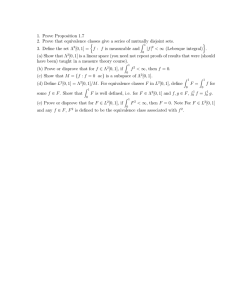
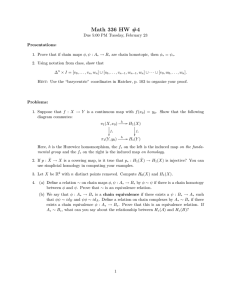
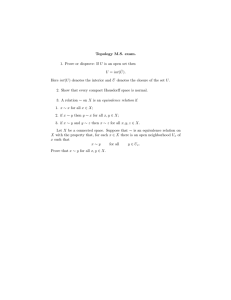

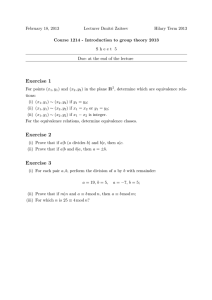
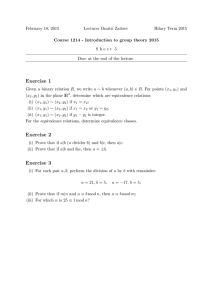
![MA1124 Assignment3 [due Monday 2 February, 2015]](http://s2.studylib.net/store/data/010730345_1-77978f6f6a108f3caa941354ea8099bb-300x300.png)
